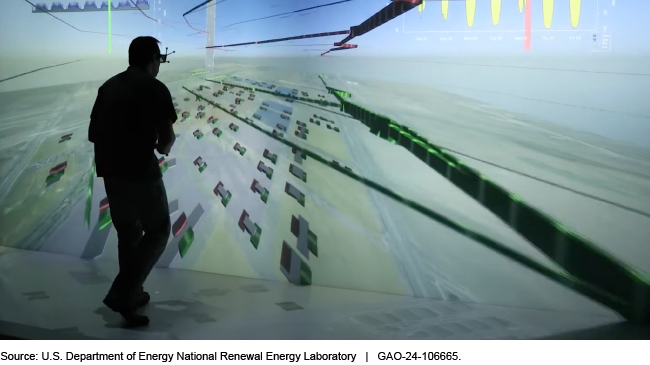Immersive Technologies: Most Civilian Agencies Are Using or Plan to Use Augmented Reality, Virtual Reality, and More
Fast Facts
Immersive technologies integrate the physical environment with digital content. Their uses have expanded beyond entertainment to include education, training, and more.
We surveyed 23 civilian federal agencies on their use of and plans for immersive technologies.
Most of the agencies use them, often for training. For example, the Department of Homeland Security uses simulators as part of law enforcement training on the use of force. It used these technologies to train nearly 10,000 employees in a variety of areas in FY 2022.
15 agencies planned to increase use.
Challenges cited included meeting cybersecurity requirements and high costs.
Another Example: A Department of Energy Laboratory Uses an Immersive Room to Visualize Energy Data

Highlights
What GAO Found
Federal civilian agencies use immersive technologies to train workers, improve agency processes, interact with the public, and execute their missions, among other reasons. In response to GAO's survey, 17 of the 23 civilian agencies reported activities involving immersive technologies in fiscal years 2022 and 2023, with 13 agencies reporting benefits from their use. Agencies used the technologies for workforce training and public outreach most often. For example, the Department of Homeland Security used simulators and other immersive technologies to train nearly 10,000 of its employees in fiscal year 2022 for law enforcement use-of-force training, transportation security training, and fire and emergency response training. The Department of Veterans Affairs used immersive technologies, such as virtual reality, as a tool for clinical staff to support mental health treatment, physical rehabilitation, and pain management. Agencies reported a better understanding of data, increased safety, and improved decision making as the most beneficial aspects of using immersive technologies.
Examples of How Federal Civilian Agencies Are Using Immersive Technologies

Sixteen agencies reported plans to expand their activities involving immersive technologies during fiscal years 2024–2028. These agencies plan to use these technologies most frequently for data visualization and analysis, design and planning, public outreach, and remote collaboration. For example, the Department of Transportation's Federal Aviation Administration plans to use immersive technologies to demonstrate new architectural designs and concepts. Of the 16 agencies, 15 reported plans to adopt or expand their use of immersive technologies and 13 reported plans to conduct or fund research and development.
The most often cited challenges among agencies that have used or adopted the technologies were with meeting cybersecurity and privacy requirements and with high operation and maintenance costs. Agencies that do not plan to adopt or expand their use identified cybersecurity requirements as the most common barrier. In addition, immersive technologies may not be conducive to an agency's mission or the types of tasks its staff perform.
Why GAO Did This Study
Immersive technologies integrate the physical environment with digital content to support user engagement. As the capabilities of these technologies expand, the need to understand in a comprehensive way how federal agencies are using them has become increasingly important.
GAO was asked to review how immersive technologies are used across federal civilian agencies. This report identifies and discusses (1) the federal civilian agencies that had programs or activities involving immersive technologies in 2022 and 2023, including the purposes and reported benefits of those technologies; (2) federal civilian agencies' plans for programs or activities involving immersive technologies for fiscal years 2024 through 2028; and (3) the challenges federal civilian agencies reported on the use and adoption of immersive technology.
GAO surveyed the 23 civilian agencies defined in the Chief Financial Officers Act of 1990, as amended. GAO received responses from all 23 agencies. Survey topics included the types and use of immersive technologies and the benefits and challenges associated with their use and adoption. GAO contacted agencies in writing or through interviews, as needed, to clarify responses to the survey.
For more information, contact Brian Bothwell at (202) 512-6888 or bothwellb@gao.gov.
